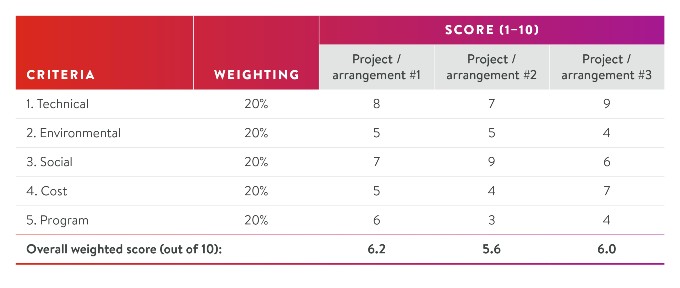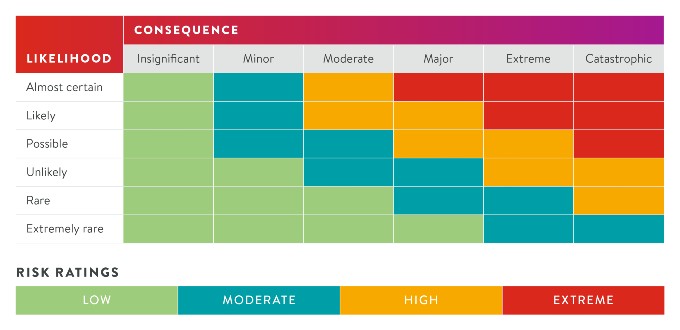THOUGHT LEADERSHIP
Make better decisions about hydropower and dam project options using risk-based multi-criteria assessment
How can owners or developers assess alternative options for hydropower and dam projects objectively and consistently? How can you maintain an appropriate balance among the environmental, social, financial and technical risks? If you place a value on the non-cost aspects of projects, how can you confidently assess the many criteria that your project options bring into play?
Traditional methods aren’t always best
The traditional approach to evaluating a range of alternative project arrangements and selecting a preferred option would be to apply a numerical ranking and weighting to a range of criteria to reach a weighted score for each project option (as shown in the table below). The recommended project arrangement would generally be the one with the highest weighted score. However, there are some major downsides to this methodology.
One problem with the traditional method is that the guideline for scoring can be fairly arbitrary (e.g. 1 = poor, 10 = excellent or 1 = high cost, 10 = low cost). Furthermore, scoring can be subjective and can vary from assessor to assessor. A project with strong scores in some areas may still achieve the highest weighted score even if it has low scores in other areas – and this can be accentuated by varying the weighting of individual criteria to contribute less to the overall score. Individual low scores can be very important as they could be show-stoppers. The averaging approach can therefore be misleading. The lack of transparency of this traditional approach can make it difficult to explain the results to internal and external stakeholders.
An alternative approach is a risk-based method.
A risk-based approach to multi-criteria analysis brings benefits
Compared with the traditional method, a risk-based approach may lead to a less subjective and more defensible assessment, as a consistent set of criteria is applied across all projects and/or arrangements. High risks remain very visible because there is no weighting or averaging. This process can be easily explained to internal and external stakeholders.
A risk-based approach uses a risk rating table, similar to that shown below, which can be used to rate the risks of many different types of hazards. This approach is familiar to many because it is used extensively throughout industry in many applications including, for example, safety management.
The standard risk assessment process is followed, which involves identifying the hazards, assessing the likelihood and consequence and therefore risk, identifying mitigation measures and re-evaluating.
Define the likelihood and consequences of risks
To undertake a multi-criteria assessment using a risk-based framework, you first need to develop a set of definitions for consequence and likelihood. The definitions should relate to a set of criteria, for example a hydropower project may consider natural environment, social and cultural heritage, reputation and client relationships, planning and approvals, and project delivery. For each criterion, define the consequence, ranging from a ‘Low’ through to a ‘Catastrophic’ outcome.
Developing these consequence definitions can be complex and require endorsement from within the owner’s or developer’s organisation. Many organisations already have a set of relevant consequence definitions as part of their corporate risk management processes. In some cases, these definitions may need amending (e.g. to accommodate a larger project); however, this could potentially be easier and more efficient than starting from scratch.
Developing a likelihood table is relatively straightforward. It simply requires a probability range to be associated with each likelihood definition, for example ‘Almost certain’ = 90–100%. The likelihood table can then be applied in subsequent risk assessments.
Once the consequence and likelihood definitions are agreed, you’re ready to undertake the multi-criteria assessment using a risk-based framework.
Nine steps towards a robust multi-criteria options assessment
Depending on the project, a multi-criteria assessment will often involve considering the cost, schedule and risk of each option.
The following checklist sets out a nine-step method to guide a risk-based multi-criteria assessment of alternative options for a hydropower, pumped hydro energy storage or dam project.
The steps set out above can be repeated to review other project options.
Ultimately, a degree of subjective evaluation may be needed, but this methodology will certainly support you to consider multiple criteria in your decision-making process, and is likely to highlight any major risks that may be considered to be show-stoppers. Using a risk-based approach and following the methodology above will set you on a solid path towards a consistent and defensible approach for your options assessment.
If you would like to discuss how Entura can assist with assessing your project options and their associated risks, including multi-criteria assessment of your hydropower, pumped hydro energy storage or dam project, please contact Phillip Ellerton on +61 439 010 172, Tim Griggs on +61 409 365 329 or Richard Herweynen on +61 429 705 127.
About the author
Tim Griggs is a specialist civil engineer with the hydropower and pumped hydro energy storage team at Entura. He has over 25 years of experience in the fields of civil engineering, dams and hydropower including feasibility studies, design and construction support, and has worked on projects located in Australia and the Indo-Pacific region. He is currently the hydropower design leader for Hydro Tasmania’s Battery of the Nation project that is undertaking feasibility studies into the development of a large pumped hydro energy storage project in Tasmania.
MORE THOUGHT LEADERSHIP ARTICLES
April 27, 2021









